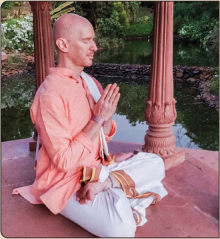
Photo: Sri Patanjali’s prescription for working with the kleshas.
Patanjali called the things that cause us to suffer kleshas, or obstructions. He named five of them. The first, avidya, is that we do not fully know who we are. Avidya is often translated as ignorance. The ignorance it refers to is that, while we might know a lot about many topics, we do not fully know who we truly are.
It is this incompleteness of knowing that allows four other kleshas to arise: a false narrative about who think we are (asmita); our likes and dislikes (raga and dvesha); and clinging to life (abhinivesha).
Several years ago I became fascinated by the question of why, if Yoga was for the removal of avidya and other kleshas, did we need to do physical things like asanas and pranayama? The kleshas are basically mental misperceptions. How could a physical practice change something on the level of the mind? Why not work with the mind directly? Most people have experienced that the mind is very difficult to work with directly—meaning it’s difficult to control—because when we think of our mind we think of it as being composed of thoughts, and thinking often can get out of control. We ruminate, become compulsive, imagine scenarios that may never happen; and each time we engage in these thoughts we imagine that they are real. Thinking something to be real that is not real is called a misperception, and misperception is intimately tied into the reason why we do not know, fully and truly, who we are.
In the Yoga Sutras, thoughts are not the mind, thoughts are activities that occur in a neutral field called chitta. Those activities are thoughts, emotions, sensations, information and memory. Called vrittis, they form the basis of our identity, but, as the often-used analogy goes, they are just ripples on the surface of the ocean, not the depths of ocean or the entirety of the ocean itself. One of the ways that the ocean expresses itself is through currents, ripples and waves; one of the ways that the field of chitta expresses itself is through ripples and waves that make up the form of our body and nervous system. So, to work first with our bodies, and the things that make our body go, is to calm the ripples, so we can experience the depths of the ocean, so to speak, the source of being.
In the first section of chapter two of Patanjali’s Yoga Sutras, we find a selection of about twelve aphorisms that discuss Kriya Yoga, the actions in Yoga that thin or reduce the obstructions or afflictions of the mind (the reasons we suffer) and prepare us for the inner radiance of samadhi. Kriya means action, and the kriyas are the indirect actions in Yoga that accomplish the above stated results. Why indirect? Because the direct action of samadhi, outlined in chapter one, addresses a mind that is fit for one-pointed focus already.
But what about the rest of us, who are prone to semi-distracted states of mind? Those who can focus for a while, but then find our minds wandering off to different states of distraction. What can we do to move towards deeper states of yogic contemplation? We can do the kriyas. Patanjali defines three of these:
Tapas: practices pertaining to the physical body, such as asanas, pranayama and the ethical restrictions of the yamas.
Svadhyaya: repetition of mantras, study of sacred texts and self-evaluation.
Ishvara Pranidhana: surrender to God or any conception of the Divine.
These practices are prescribed by Patanjali to thin the kleshas, the obstacles, which are critical enough to deserve a deeper discussion in the next installment of this series.
About the Author:
 Eddie Stern is a Yoga instructor and author from New York City. His latest book is One Simple Thing, A New Look at the Science of Yoga and How it Can Change Your Life, and his newest app is “Yoga365, micro-practices for an aware life.” His daily, live Yoga classes can be found on www.eddiestern.com
Eddie Stern is a Yoga instructor and author from New York City. His latest book is One Simple Thing, A New Look at the Science of Yoga and How it Can Change Your Life, and his newest app is “Yoga365, micro-practices for an aware life.” His daily, live Yoga classes can be found on www.eddiestern.com
(Reprinted from Hinduism Today)

